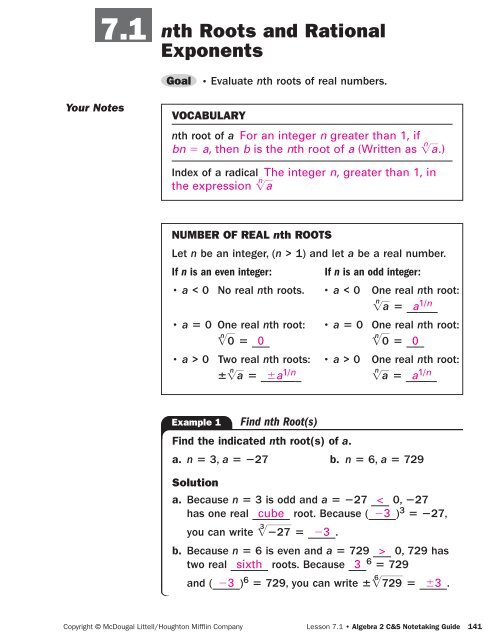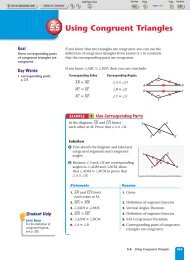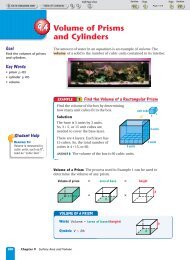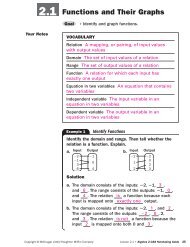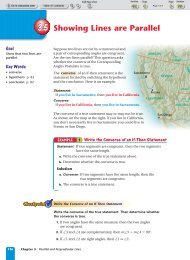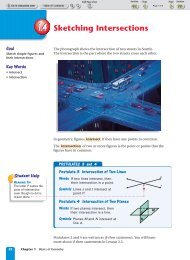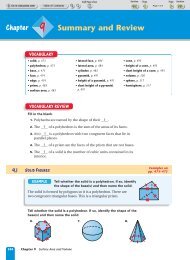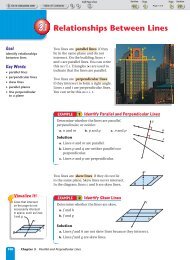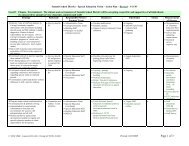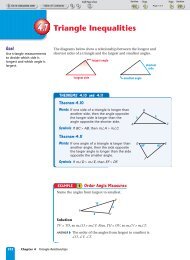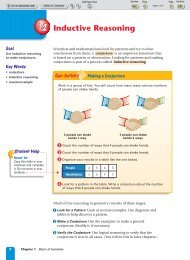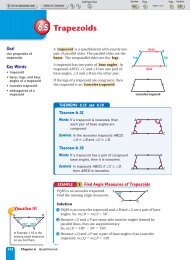Notes with answers
Notes with answers
Notes with answers
You also want an ePaper? Increase the reach of your titles
YUMPU automatically turns print PDFs into web optimized ePapers that Google loves.
7.1<br />
Your <strong>Notes</strong><br />
nth Roots and Rational<br />
Exponents<br />
Goal p Evaluate nth roots of real numbers.<br />
VocabulaRy<br />
nth root of a For an integer n greater than 1, if<br />
bn 5 a, then b is the nth root of a (Written as n<br />
Ï }<br />
a .)<br />
Index of a radical The integer n, greater than 1, in<br />
the expression n<br />
a<br />
Ï }<br />
NumbER of REal nth Roots<br />
Let n be an integer, (n > 1) and let a be a real number.<br />
If n is an even integer: If n is an odd integer:<br />
• a < 0 No real nth roots. • a < 0 One real nth root:<br />
n<br />
Ï }<br />
a 5 a 1/n<br />
• a 5 0 One real nth root: • a 5 0 One real nth root:<br />
n<br />
0 5 0<br />
n<br />
0 5 0<br />
Ï }<br />
Ï }<br />
• a > 0 Two real nth roots: • a > 0 One real nth root:<br />
6 n<br />
Ï }<br />
a 5 6a 1/n<br />
Example 1 Find nth Root(s)<br />
Find the indicated nth root(s) of a.<br />
n<br />
Ï }<br />
a 5 a 1/n<br />
a. n 5 3, a 5 227 b. n 5 6, a 5 729<br />
solution<br />
a. Because n 5 3 is odd and a 5 227 < 0, 227<br />
has one real cube root. Because ( 23 ) 3 5 227,<br />
you can write 3 Ï }<br />
227 5 23 .<br />
b. Because n 5 6 is even and a 5 729 > 0, 729 has<br />
two real sixth roots. Because 3 6 5 729<br />
and ( 23 ) 6 5 729, you can write 6 6 Ï }<br />
729 5 63 .<br />
Copyright © McDougal Littell/Houghton Mifflin Company Lesson 7.1 • Algebra 2 C&S Notetaking Guide 141
Your <strong>Notes</strong><br />
Example 2 Solve Equations Using nth Roots<br />
Solve the equation.<br />
a. 2x 6 5 1458 b. (x 2 4) 3 5 64<br />
Solution<br />
a. 2x6 5 1458 b. (x 2 4) 3 5 64<br />
x6 5 729 x 2 4 5 3 Ï }<br />
64<br />
Checkpoint Find the indicated nth root(s) of a.<br />
1. n 5 4, a 5 625<br />
25, 5<br />
Solve the equation.<br />
3. 3x 5 5 729<br />
3<br />
x 5 6 6<br />
Ï }<br />
729 x 2 4 5 4<br />
x 5 63 x 5 8<br />
2. n 5 3, a 5 512<br />
8<br />
4. (x 1 6) 4 5 256<br />
210, 22<br />
Example 3 Evaluate Expressions <strong>with</strong> Rational Exponents<br />
Evaluate the expression.<br />
a. 8 1/3 b. 64 1/2<br />
c. (21024) 1/5 d. (216) 1/4<br />
Solution<br />
a. 81/3 5 3 Ï }<br />
8 5 2<br />
b. 641/2 5 Ï }<br />
64 5 8<br />
c. (21024) 1/5 5 5 Ï }<br />
21024 5 24<br />
d. (216) 1/4 5 4<br />
Ï }<br />
216 , no real solution<br />
142 Lesson 7.1 • Algebra 2 C&S Notetaking Guide Copyright © McDougal Littell/Houghton Mifflin Company
Your <strong>Notes</strong><br />
Homework<br />
Rational ExponEnts<br />
Let a 1/n be an nth root of a (a > 0 and a Þ 1), and<br />
let m be a positive integer.<br />
a m/n 5 (a 1/n ) m 5 ( n<br />
Ï }<br />
a ) m<br />
a2m/n 5 1<br />
}<br />
a<br />
1<br />
(a1/n 5<br />
) m 1<br />
5 }<br />
m/n<br />
Example 4 Rewrite Expressions<br />
}<br />
1 n<br />
Ï }<br />
a 2 m<br />
a. Rewrite 1 3<br />
Ï }<br />
7 2 4 using rational exponents.<br />
b. Rewrite 9 23/5 using radicals.<br />
a. 1 3<br />
Ï }<br />
7 2 4 5 (7 1/ 3 ) 4 5 7 4/3<br />
b. 923/5 5 1<br />
9<br />
5.<br />
} 5<br />
3/5 1<br />
}<br />
1 91/5 5<br />
2 3 1<br />
}<br />
1 5<br />
Ï }<br />
9 2 3<br />
Example 5 Evaluate Expressions <strong>with</strong> Rational Exponents<br />
a. Evaluate 32 22/5 . b. Evaluate 8 4/3 .<br />
a. 3222/5 5 1<br />
}<br />
1<br />
5 }<br />
322/5 1 5<br />
Ï }<br />
32 2<br />
b. 8 4/3 5 1 3<br />
Ï }<br />
8 2 4 5 2 4 5 16<br />
Checkpoint Rewrite the expression.<br />
1<br />
}<br />
1 3<br />
Ï }<br />
7 2 8<br />
7 23/8<br />
Evaluate the expression.<br />
7. (2125) 22/3<br />
1<br />
}<br />
25<br />
1 1<br />
5 } 5 }<br />
2 2 4<br />
2<br />
6. 5 4/9<br />
1 9<br />
Ï }<br />
5 2 4<br />
8. 16 3/2<br />
Copyright © McDougal Littell/Houghton Mifflin Company Lesson 7.1 • Algebra 2 C&S Notetaking Guide 143<br />
64
7.2<br />
Your <strong>Notes</strong><br />
Properties of Rational<br />
Exponents<br />
Goal p Use properties of radicals and rational exponents.<br />
VocabulaRy<br />
Simplest form of a radical For a radical <strong>with</strong> index<br />
n, the form where there are no perfect nth powers<br />
in the radicand, and there are no radicals in any<br />
denominators<br />
Like radicals Radicals that have the same index and<br />
the same radicand<br />
PRoduct and QuotiEnt PRoPERtiEs of Radicals<br />
Product Property n<br />
Ï }<br />
a p b 5 n<br />
Ï }<br />
a p n<br />
Ï }<br />
b<br />
Ï }<br />
Quotient Property n a<br />
}<br />
b 5 n<br />
Ï }<br />
a<br />
} n<br />
b<br />
Ï }<br />
Example 1 Use Properties of Radicals<br />
Use the properties of radicals to simplify the expression.<br />
a. 5<br />
Ï }<br />
27 p 5<br />
Ï }<br />
9 5 5<br />
Ï }<br />
27 p 9 Product property<br />
b. 3<br />
Ï }<br />
192<br />
}<br />
3<br />
Ï }<br />
3<br />
5 3<br />
5 5<br />
Ï }}<br />
3 p 3 p 3 p 3 p 3 5 3<br />
}<br />
Ï 192<br />
}<br />
Ï }<br />
Write 5<br />
Ï }<br />
128 in simplest form.<br />
5<br />
Ï }<br />
128 5 5<br />
Ï }<br />
32 p 4<br />
5<br />
3 3<br />
64 5 4 Quotient property<br />
Example 2 Write Radicals in Simplest Form<br />
Factor out perfect fifth power.<br />
5 5<br />
Ï }<br />
32 p 5<br />
Ï }<br />
4 Product property of radicals<br />
5 2 5<br />
Ï }<br />
4 Simplify.<br />
144 Lesson 7.2 • Algebra 2 C&S Notetaking Guide Copyright © McDougal Littell/Houghton Mifflin Company
Your <strong>Notes</strong><br />
ProPerties of rational exPonents<br />
Let a and b be positive real numbers. Let m and n<br />
be rational numbers.<br />
PROPERTY EXAMPLE<br />
1. am p an 5 am 1 n 41/2 p 43/2 5 4 ( 1/2 1 3/2 )<br />
5 42 5 16<br />
2. (am ) n 5 amn (25/2 ) 2 5 2 ( 5/2 p 2 )<br />
5 25 5 32<br />
3. (ab) m 5 a m b n (16 p 4) 1/2 5 16 1/2 p 4 1/2<br />
4. a2m 5 1<br />
}<br />
am , a Þ 0 2521/2 5 1<br />
}<br />
5. am<br />
}<br />
6. 1 a<br />
}<br />
5 4 p 2 5 8<br />
251/2 5 1<br />
}<br />
5<br />
an 5 am 2 n , a Þ 0 35/2<br />
}<br />
31/2 5 3( 5/2 2 1/2 ) 5 32 5 9<br />
b 2 m 5 am<br />
}<br />
bm , b Þ 0 1 27<br />
}<br />
8 2 1/3 5 271/3<br />
}<br />
81/3 5 3<br />
}<br />
2<br />
example 3 Use Properties of Rational Exponents<br />
Simplify the expression.<br />
a. 9 1/2 p 9 1/4 5 9 ( 1/2 1 1/4 ) 5 9 3/4<br />
b. (7 2/3 ) 3 5 7 ( 2/3 p 3 ) 5 7 2 5 49<br />
c. 1 16<br />
}<br />
625 2 1/4 5 161/4<br />
}<br />
d. 81 21/4 5 1<br />
}<br />
6251/4 5 2<br />
}<br />
5<br />
811/4 5 1<br />
}<br />
3<br />
e. 35/6<br />
}<br />
31/3 5 3( 5/6 2 1/3 ) 5 33/6 5 3 1/2 5 Ï }<br />
3<br />
example 4 Add or Subtract Like Radicals<br />
Perform the indicated operation.<br />
a. 6 4<br />
Ï }<br />
5 1 8 4<br />
Ï }<br />
5 5 ( 6 1 8 ) 4<br />
Ï }<br />
5 5 14 4<br />
Ï }<br />
5<br />
b. 12(4 3/5 ) 2 5(4 3/5 ) 5 ( 12 2 5 )4 3/5 5 7 (4 3/5 )<br />
Copyright © McDougal Littell/Houghton Mifflin Company Lesson 7.2 • Algebra 2 C&S Notetaking Guide 145
Your <strong>Notes</strong><br />
Checkpoint Simplify the expression.<br />
1. Ï} 245<br />
}<br />
Ï }<br />
5<br />
7<br />
3. 3 Ï }<br />
250<br />
5 3<br />
Ï }<br />
2<br />
2. 3 Ï }<br />
6 p 3 Ï }<br />
36<br />
6<br />
4. 14(4 2/3 ) 2 12(4 2/3 )<br />
2(4 2/3 )<br />
Example 5 Simplify Expressions <strong>with</strong> Variables<br />
Simplify the expression. Write the answer using positive<br />
exponents only. Assume all variables are positive.<br />
a. 5 Ï }<br />
32x15 5 5<br />
Ï }<br />
25 (x3 ) 5 Factor out perfect fifth powers.<br />
b. (36m 4 n 10 ) 1/2<br />
Ï<br />
c. 3<br />
5 2x 3 Simplify.<br />
5 36 1/2 (m 4 ) 1/2 (n 10 ) 1/2 Power of a product<br />
property<br />
5 36 1/2 m ( 4 p 1/2 ) n ( 10 p 1/2 ) Power of a power<br />
property<br />
5 6m 2 n 5 Simplify.<br />
}<br />
a9 } 5 6<br />
b<br />
5 a3<br />
}<br />
b 2<br />
d. 42x3/2 z 7<br />
}<br />
6x 4 y 23 z 5<br />
Ï}<br />
3<br />
(a3 ) 3<br />
}<br />
(b 2 ) 3<br />
Factor out perfect cube powers.<br />
Simplify.<br />
5 42<br />
}<br />
6 x( 3/2 2 4 ) y [0 2 (23) ] z ( 7 2 5 ) Quotient of<br />
powers property<br />
5 7x 25/2 y 3 z 2 5 7y3z2 }<br />
x5/2 Simplify.<br />
146 Lesson 7.2 • Algebra 2 C&S Notetaking Guide Copyright © McDougal Littell/Houghton Mifflin Company
Your <strong>Notes</strong><br />
Homework<br />
Example 6 Add/Subtract Expressions <strong>with</strong> Variables<br />
Simplify the expression. Assume all variables are<br />
positive.<br />
a. 10 5 Ï }<br />
y 2 6 5 Ï }<br />
y b. 3a 2 b 1/4 1 4a 2 b 1/4<br />
Solution<br />
a. 10 5 Ï }<br />
y 2 6 5 Ï }<br />
y 5 ( 10 2 6 ) 5 Ï }<br />
y<br />
5 4 5 Ï }<br />
y<br />
b. 3a 2 b 1/4 1 4a 2 b 1/4 5 ( 3 1 4 )a 2 b 1/4<br />
5 7a 2 b 1/4<br />
Checkpoint Simplify the expression. Write your answer<br />
using positive exponents only. Assume all variables<br />
are positive.<br />
5. 3 Ï }<br />
8x 7 y 3 z 11<br />
2x2yz3 3<br />
Ï }<br />
xz2 6. c5 d 1/2<br />
}<br />
4cd 5/2<br />
c 4<br />
}<br />
4d 2<br />
Simplify the expression. Assume all variables are positive.<br />
7. 9 7 Ï }<br />
5y4 1 16 7 Ï }<br />
5y4 25 7<br />
Ï }<br />
5y4 8. 8k 5/9 2 7k 5/9<br />
Copyright © McDougal Littell/Houghton Mifflin Company Lesson 7.2 • Algebra 2 C&S Notetaking Guide 147<br />
k 5/9
Your <strong>Notes</strong><br />
7.3 Solving Radical Equations<br />
Goal p Solve equations that contain radicals or rational<br />
exponents.<br />
VocabulaRy<br />
Radical equation An equation that contains radicals<br />
<strong>with</strong> the variable in the radicand<br />
Extraneous solution An apparent solution that does<br />
not make the original equation true<br />
SolVinG Radical EquationS<br />
To solve a radical equation, follow these steps:<br />
Step 1 Isolate the radical on one side of the<br />
equation, if necessary.<br />
Step 2 Raise each side of the equation to the<br />
same power to eliminate the radical.<br />
Step 3 Solve the resulting equation using techniques<br />
that you learned in previous chapters.<br />
Step 4 Check your solution.<br />
Example 1 Solve a Radical Equation<br />
Solve Ï }<br />
x 1 6 5 3.<br />
Solution<br />
Ï }<br />
x 1 6 5 3 Write original equation.<br />
1 Ï }<br />
x 1 6 2 2 5 32 Square each side to eliminate the<br />
radical.<br />
x 1 6 5 9 Simplify.<br />
x 5 3 Subtract 6 from each side.<br />
148 Lesson 7.3 • Algebra 2 C&S Notetaking Guide Copyright © McDougal Littell/Houghton Mifflin Company
Your <strong>Notes</strong><br />
Example 2 Solve an Equation <strong>with</strong> Two Radicals<br />
Solve Ï }<br />
2x 1 1 2 Ï }<br />
10 2 x 5 0.<br />
Solution<br />
Ï }<br />
2x 1 1 2 Ï }<br />
10 2 x 5 0 Original equation<br />
Ï }<br />
2x 1 1 5 Ï }<br />
10 2 x Add Ï }<br />
10 2 x<br />
to each side.<br />
1 Ï }<br />
2x 1 1 2 2 5 1 Ï }<br />
10 2 x 2 2 Square each side.<br />
2x 1 1 5 10 2 x Simplify.<br />
2x 5 9 2 x Subtract 1<br />
from each side.<br />
3x 5 9 Add x to each side.<br />
x 5 3 Solve for x.<br />
Example 3 Solve an Equation <strong>with</strong> an Extraneous Solution<br />
Solve x 2 2 5 Ï }<br />
x 1 10 . Check for extraneous solutions.<br />
Solution<br />
x 2 2 5 Ï }<br />
x 1 10 Original equation<br />
(x 2 2) 2 5 1 Ï }<br />
x 1 10 2 2 Square each side.<br />
x 2 2 4x 1 4 5 x 1 10 Expand left side;<br />
simplify right side.<br />
x 2 2 5x 2 6 5 0 Standard form<br />
( x 2 6 )( x 1 1 ) 5 0 Factor.<br />
x 2 6 5 0 or x 1 1 5 0 Zero product property<br />
x 5 6 or x 5 21 Solve for x.<br />
CHECK Substitute 6 for x and 21 for x in the original<br />
equation.<br />
6 2 2 0 Ï }<br />
6 1 10 21 2 2 0 Ï }<br />
21 1 10<br />
4 0 Ï }<br />
16 23 0 Ï }<br />
9<br />
4 5 4 ✓ 23 Þ 3 ✓<br />
Because 21 does not satisfy the original equation, the<br />
only solution is 6 .<br />
Copyright © McDougal Littell/Houghton Mifflin Company Lesson 7.3 • Algebra 2 C&S Notetaking Guide 149
Your <strong>Notes</strong><br />
Homework<br />
Example 4 Solve an Equation <strong>with</strong> Rational Exponents<br />
Solve (3x 1 4) 2/3 5 16. Check for extraneous solutions.<br />
Solution<br />
(3x 1 4) 2/3 5 16 Write original equation.<br />
[(3x 1 4) 2/3 ] 3/2 5 (16) 3/2 Raise each side to the 3<br />
}<br />
2<br />
power.<br />
3x 1 4 5 1 Ï }<br />
162 3<br />
3x 1 4 5 64 Simplify.<br />
Definition of rational<br />
exponents<br />
3x 5 60 Subtract 4 from each<br />
side.<br />
x 5 20 Divide each side by 3 .<br />
The solution is 20 . Check this in the original equation.<br />
Checkpoint Solve the equation. Check for extraneous<br />
solutions.<br />
1. 4 Ï }<br />
x 1 3 5 2<br />
13<br />
3. Ï }<br />
4x 1 5 5 3Ï }<br />
x<br />
1<br />
5. 22x 4/3 2 21 5 253<br />
28 or 8<br />
2. 3 Ï }<br />
x 2 5 1 1 5 21<br />
23<br />
4. Ï }<br />
3x 2 Ï }<br />
x 1 14 5 0<br />
7<br />
6. x 1 2 5 Ï }<br />
2x 1 7<br />
150 Lesson 7.3 • Algebra 2 C&S Notetaking Guide Copyright © McDougal Littell/Houghton Mifflin Company<br />
1
Your <strong>Notes</strong><br />
7.4 Function Operations and<br />
Composition of Functions<br />
Goal p Perform operations <strong>with</strong> functions, including<br />
composition of functions.<br />
VOCabulary<br />
Composition of functions Composing a function f<br />
<strong>with</strong> a function g is accomplished by replacing<br />
each variable in f <strong>with</strong> the expression for g<br />
OperatiOns On FunCtiOns<br />
Let f(x) and g(x) be any two functions. You can add,<br />
subtract, multiply, or divide f(x) and g(x) to form a new<br />
function h(x).<br />
Operation Definition Example: f(x) 5 3x,<br />
g(x) 5 x 1 3<br />
Addition h(x) 5 f(x) 1 g(x) h(x) 5 3x 1 (x 1 3)<br />
5 4x 1 3<br />
Subtraction h(x) 5 f(x) 2 g(x) h(x) 5 3x 2 (x 1 3)<br />
5 2x 2 3<br />
Multiplication h(x) 5 f(x) p g(x) h(x) 5 3x(x 1 3)<br />
5 3x2 1 9x<br />
Division h(x) 5 f(x)<br />
}<br />
g(x)<br />
3x<br />
h( x) 5 }<br />
x 1 3 ,<br />
x Þ 23<br />
The domain of h consists of the x-values that are in the<br />
domains of both f and g . When h involves division,<br />
the domain does not include x-values for which<br />
the denominator is equal to zero .<br />
Copyright © McDougal Littell/Houghton Mifflin Company Lesson 7.4 • Algebra 2 C&S Notetaking Guide 151
Your <strong>Notes</strong><br />
Example 1 Add and Subtract Functions<br />
Let f(x) 5 3x 2 1 1 and g(x) 5 x 2 5. Find h(x) and<br />
state its domain.<br />
a. h(x) 5 f(x) 1 g(x) b. h(x) 5 f(x) 2 g(x)<br />
Solution<br />
a. f(x) 1 g(x) 5 3x 2 1 1 1 (x 2 5)<br />
5 3x 2 1 x 2 4<br />
b. f(x) 2 g(x) 5 3x 2 1 1 2 (x 2 5)<br />
5 3x 2 2 x 1 6<br />
In both parts (a) and (b), the domains of f and g are<br />
all real numbers . So, the domain of h is<br />
all real numbers .<br />
Example 2 Multiply and Divide Functions<br />
Let f(x) 5 x3 and g(x) 5 7x. Find h(x) and state its<br />
domain.<br />
a. h(x) 5 f(x) p g(x) b. h(x) 5 f(x)<br />
}<br />
g(x)<br />
Solution<br />
a. f(x) p g(x) 5 (x 3 )(7x)<br />
b.<br />
5 7x 4<br />
The domains of both f and g are all real numbers .<br />
So, the domain of h(x) is all real numbers .<br />
f(x)<br />
}<br />
g(x)<br />
5 x3<br />
}<br />
7x<br />
5 1<br />
} x ( 3 2 1 )<br />
7<br />
5 1<br />
}<br />
7 x 2<br />
Because g(0) 5 0 , f<br />
}<br />
g is undefined when x 5 0 .<br />
So, the domain of h(x) is all real numbers<br />
except 0 .<br />
152 Lesson 7.4 • Algebra 2 C&S Notetaking Guide Copyright © McDougal Littell/Houghton Mifflin Company
Your <strong>Notes</strong><br />
Checkpoint Complete the following exercise.<br />
1. Let f(x) 5 5x3 and g(x) 5 22x3 . Find (a) f 1 g,<br />
(b) f 2 g, (c) f p g, (d) f<br />
} , and (e) the domains.<br />
g<br />
a. 3x3 b. 7x3 c. 210x6 d. 2 1<br />
}<br />
7<br />
e. The domain of f 1 g, f 2 g, and f p g is all real<br />
numbers. The domain of f<br />
}<br />
g<br />
is all real numbers<br />
except 0.<br />
Composition of funCtions<br />
The composition of a function f <strong>with</strong> a function g is:<br />
h(x) 5 g(f (x))<br />
The domain of h is the set of all x-values where x is<br />
in the domain of g and g(x) is in the domain of f .<br />
Domain of g Range of g<br />
Input<br />
of g<br />
x<br />
Output<br />
of g<br />
g(x)<br />
Input<br />
of f<br />
f(g(x))<br />
Output<br />
of f<br />
Domain of f Range of f<br />
Copyright © McDougal Littell/Houghton Mifflin Company Lesson 7.4 • Algebra 2 C&S Notetaking Guide 153
Your <strong>Notes</strong><br />
Homework<br />
Example 3 Write a Composition of Functions<br />
Let f (x) 5 6x and g(x) 5 3x 1 5. Find the following.<br />
a. f (g(x)) b. g(f (x))<br />
c. the domain of each composition<br />
Solution<br />
To find the compositions, write the composition, substitute<br />
the expression for the inner function in the outer<br />
function, and simplify.<br />
a. f (g(x)) 5 f( 3x 1 5 ) 5 6( 3x 1 5 ) 5 18x 1 30<br />
b. g(f (x)) 5 g( 3x ) 5 3( 3x ) 1 5 5 18x 1 5<br />
c. The domain of each function is all real numbers , so<br />
the domain of each composition is all real numbers .<br />
Example 4 Evaluate a Composition of Functions<br />
Let f(x) 5 6x and g(x) 5 3x 1 5. Evaluate f(g(22)).<br />
Solution<br />
To evaluate f(g(22)), first find g(22):<br />
g(22) 5 3( 22 ) 1 5 5 26 1 5 5 21<br />
Then substitute g(22) 5 21 into f (g(22)):<br />
f(g(22)) 5 f( 21 ) 5 6( 21 ) 5 26<br />
Checkpoint Complete the following exercise.<br />
2. Let f (x) 5 5x 2 4 and g(x) 5 3x. Find<br />
(a) f (g(x)), (b) g(f (x)), (c) f (g(23)), and (d) g(f (4)).<br />
a. 15x 2 4 b. 15x 2 12 c. 249 d. 48<br />
154 Lesson 7.4 • Algebra 2 C&S Notetaking Guide Copyright © McDougal Littell/Houghton Mifflin Company
7.5<br />
Your <strong>Notes</strong><br />
Inverse Functions<br />
Goal p Find the inverses of linear and nonlinear functions.<br />
Vocabulary<br />
Inverse relation A relation that switches the input<br />
and output values of the original relation<br />
Inverse functions If a relation and its inverse are<br />
functions, then the two functions are inverse<br />
functions.<br />
InVerse FunctIons<br />
Functions f and g are inverses if:<br />
f(g(x)) 5 x and g(f (x)) 5 x<br />
The inverse of f is denoted by f –1 , which is read as<br />
“f inverse .”<br />
example 1 Verify Inverse Functions<br />
Verify that f(x) 5 7x 2 4 and g(x) 5 1<br />
} x 1<br />
7 4<br />
} are inverse<br />
7<br />
functions.<br />
solution<br />
To verify f(x) and g(x) are inverse functions, show that<br />
f(g(x)) 5 x and g(f(x)) 5 x .<br />
f(g(x)) 5 f 1 1<br />
} x 1<br />
7<br />
4<br />
}<br />
7 2<br />
g(f(x)) 5 g(7x 2 4)<br />
5 7 1 1<br />
} x 1<br />
7 4<br />
1<br />
}<br />
7 2 2 4 5 } ( 7x 2 4 ) 1<br />
7 4<br />
}<br />
7<br />
5 x 1 4 2 4 5 x 2 4<br />
} 1<br />
7 4<br />
}<br />
7<br />
5 x ✓ 5 x ✓<br />
Copyright © McDougal Littell/Houghton Mifflin Company Lesson 7.5 • Algebra 2 C&S Notetaking Guide 155
Your <strong>Notes</strong><br />
Finding inverse Functions<br />
You can find the inverse of a function by following these<br />
steps.<br />
Step 1 Replace f(x) <strong>with</strong> y (if the function is written<br />
using function notation).<br />
Step 2 Switch x and y.<br />
Step 3 Solve for y .<br />
example 2 Find the Inverse of a Linear Function<br />
Find the inverse of the function f(x) 5 23x 1 6.<br />
solution<br />
f(x) 5 23x 1 6 Write original function.<br />
y 5 23x 1 6 Replace f(x) <strong>with</strong> y.<br />
x 5 23y 1 6 Switch x and y.<br />
x 2 6 5 23y Subtract 6 from each side.<br />
2 1<br />
} x 1 2 5 y<br />
3<br />
Divide each side by –3 to<br />
solve for y .<br />
The inverse function is f 21 (x) 5 2 1<br />
}<br />
3 x 1 2 .<br />
Checkpoint Complete the following exercise.<br />
1. Find the inverse of the function g(x) 5 7x 2 3. Then<br />
verify that the two functions are inverses of each<br />
other.<br />
g –1 x 1 3<br />
(x) 5 }<br />
7 ;<br />
g(g –1 x 1 3<br />
(x)) 5 7 1 }<br />
7 2 2 3 5 x 1 3 2 3 5 x and<br />
g –1 (7x 2 3) 1 3 7x<br />
(g(x)) 5 }} 5 } 5 x<br />
7 7<br />
156 Lesson 7.5 • Algebra 2 C&S Notetaking Guide Copyright © McDougal Littell/Houghton Mifflin Company
Your <strong>Notes</strong><br />
Homework<br />
Horizontal line test<br />
The inverse of a function f is also a function if and<br />
only if no horizontal line intersects the graph of<br />
f more than once .<br />
example 3 Find the Inverse of a Nonlinear Function<br />
Determine whether the inverse of f(x) 5 1<br />
}<br />
4 x 3 1 3 is a<br />
function. Then find the inverse.<br />
solution<br />
First, graph the function on a graphing calculator. Because<br />
no horizontal line intersects the graph more than once,<br />
the inverse of f is also a function .<br />
Next, find an equation for f21 .<br />
f(x) 5 1<br />
} x<br />
4 3 1 3 Write original function.<br />
Checkpoint Determine whether the inverse of f is a<br />
function. Then find the inverse.<br />
2. f(x) 5 2x 4 1 1, x ≥ 0<br />
y 5 1<br />
}<br />
4 x 3 1 3 Replace f(x) <strong>with</strong> y.<br />
x 5 1<br />
}<br />
4 y 3 1 3 Switch x and y.<br />
x 2 3 5 1<br />
}<br />
4 y 3 Subtract 3 from each side.<br />
4x 2 12 5 y3 Multiply each side by 4 .<br />
3<br />
Ï }<br />
4x 2 12 5 y Take the cube root of<br />
each side.<br />
yes; f21 ( x) 5 4<br />
}<br />
x 2 1<br />
} Ï<br />
x ≥ 1<br />
2 ,<br />
3. f(x) 5 1<br />
}<br />
3 x 2 2 5, x ≥ 0<br />
yes; f –1 ( x) 5 Ï }<br />
3x 1 15 ,<br />
x ≥ 25<br />
Copyright © McDougal Littell/Houghton Mifflin Company Lesson 7.5 • Algebra 2 C&S Notetaking Guide 157
7.6<br />
Your <strong>Notes</strong><br />
Graphing Square Root and<br />
Cube Root Functions<br />
Goal p Graph square root and cube root functions.<br />
VoCabulaRy<br />
Radical function A function that contains a radical<br />
<strong>with</strong> a variable in its radicand<br />
GRaphS oF SquaRe Root/Cube Root FunCtionS<br />
Square Root Function Cube Root Function<br />
(0, 0)<br />
y<br />
y 5 a x<br />
(1, a)<br />
x<br />
(21, 2a)<br />
y<br />
3 y 5 a x<br />
(1, a)<br />
(0, 0)<br />
The domain of y 5 aÏ }<br />
x<br />
is x ≥ 0. The range is<br />
The domain and range<br />
of y 5 a 3 Ï }<br />
x are<br />
y ≥ 0 when a > 0. all real numbers .<br />
example 1 Graph a Square Root Function<br />
Graph y 5 2 Ï }<br />
x . Then state its domain and range.<br />
Make a table of values. Then plot the points from the<br />
table and connect them <strong>with</strong> a smooth curve.<br />
x 0 1 2 3 4<br />
y 0 2 2.83 3.46 4<br />
1<br />
O<br />
y<br />
1<br />
y 5 2 x<br />
The radicand of a square root is always nonnegative ,<br />
so the domain is x ≥ 0. The range is y ≥ 0 .<br />
158 Lesson 7.6 • Algebra 2 C&S Notetaking Guide Copyright © McDougal Littell/Houghton Mifflin Company<br />
x<br />
x
Your <strong>Notes</strong><br />
Example 2 Graph a Cube Root Function<br />
Graph y 5 2 1<br />
}<br />
2 3<br />
Ï }<br />
x . Then state its domain and range.<br />
x –2 –1 0 1 2<br />
y 0.63 0.5 0 –0.5 –0.63<br />
y 5 2 3 1<br />
2 x<br />
1<br />
O<br />
y<br />
1<br />
x<br />
The radicand of a cube root can<br />
be any real number, so the<br />
domain is all real numbers .<br />
You can see from the graph that<br />
the range is all real numbers .<br />
Checkpoint Graph the function. Then state its domain<br />
and range.<br />
1. y 5 2 3<br />
Ï }<br />
x 2. y 5 22 Ï }<br />
x<br />
1<br />
O<br />
y<br />
1<br />
y 5 2 3 x<br />
x<br />
Graphs of radical functions<br />
To graph y 5 a Ï }<br />
x 2 h 1 k or y 5 a 3<br />
Ï }<br />
2 h 1 k:<br />
Step 1 Sketch the graph of y 5 a Ï }<br />
x or y 5 a 3<br />
Ï }<br />
x .<br />
Step 2 Determine the values of h and k. Translate the<br />
graph h units horizontally and k units<br />
vertically . If h > 0, translate the graph<br />
to the right ; if h < 0, translate it to the left .<br />
If k > 0, translate the graph up ; if k < 0,<br />
translate it down .<br />
O<br />
22<br />
y<br />
1<br />
y 5 22 x<br />
domain and range: domain: x ≥ 0,<br />
all real numbers range: y ≤ 0<br />
Copyright © McDougal Littell/Houghton Mifflin Company Lesson 7.6 • Algebra 2 C&S Notetaking Guide 159<br />
x
Your <strong>Notes</strong><br />
Homework<br />
Example 3 Graph a Square Root Function<br />
Graph y 5 Ï }<br />
x 2 1 1 2. State its domain and range.<br />
1. Sketch the graph of y 5 Ï }<br />
x .<br />
2. Determine the values of h<br />
and k. Because h 5 1 , you<br />
translate the graph of y 5 Ï }<br />
x<br />
1 unit right . Because<br />
k 5 2 , you translate the<br />
graph 2 units up .<br />
The domain is x ≥ 1 . The range is y ≥ 2 .<br />
Checkpoint Graph the function. State domain and range.<br />
3. y 5 Ï }<br />
x 1 3 1 2 4. y 5 3 Ï }<br />
x 1 1<br />
1<br />
O<br />
y<br />
y 5 x 1 3 1 2<br />
1<br />
x<br />
1<br />
O<br />
y<br />
y 5 3 x 1 1<br />
domain: x ≥ 23, domain and range:<br />
range: y ≥ 2 all real numbers<br />
1<br />
O<br />
y<br />
1<br />
1<br />
y 5 x 2 1 1 2<br />
Graph y 5 3<br />
Ï }<br />
Example 4 Graph a Cube Root Function<br />
x 1 3 2 2. State its domain and range.<br />
1. Sketch the graph of y 5 3 Ï }<br />
x .<br />
2. Determine the values of h and<br />
k. Because h 5 23 , you<br />
translate the graph of y 5 3 Ï }<br />
x<br />
3 units left . Because<br />
k 5 22 , you translate the<br />
graph 2 units down .<br />
The domain and range are all real numbers .<br />
1<br />
y 5 3 x 1 3 2 2<br />
160 Lesson 7.6 • Algebra 2 C&S Notetaking Guide Copyright © McDougal Littell/Houghton Mifflin Company<br />
y<br />
1<br />
x<br />
x<br />
x
7.7<br />
Your <strong>Notes</strong><br />
Standard Deviation<br />
Goal p Use standard deviation to describe data sets.<br />
Vocabulary<br />
Standard deviation The typical difference (or<br />
deviation) between the mean and any data value<br />
in a set<br />
StanDarD DeViation of a Set of Data<br />
To find the standard deviation of x 1 , x 2 , x 3 , …, x n :<br />
Step 1 Find the mean of the data set, }<br />
x (read as “x bar”).<br />
Step 2 Find the standard deviation s (read as “sigma”).<br />
s 5 Ï }}}}<br />
(x1 2 } x ) 2 1 (x2 2 } x ) 2 1 . . . 1 (xn 2 }<br />
x ) 2<br />
}}}}<br />
n<br />
example 1 Find Standard Deviation<br />
The height, in inches, of six trees at a nursery are<br />
shown. Find the standard deviation of the heights.<br />
36 48 50 44 53 39<br />
Solution<br />
1. Find the mean.<br />
}<br />
x 5<br />
36 1 48 1 50 1 44 1 53 1 39<br />
}}} 5 45<br />
6<br />
2. Find the standard deviation.<br />
s 5<br />
Ï }}}}}<br />
(36245)2 1 (48245) 2 1 (50245) 2 1 (44245) 2 1 (53245) 2 1 (39245) 2<br />
}}}}}}<br />
6<br />
}<br />
5 Ï 216<br />
}<br />
6<br />
5 6<br />
The standard deviation is 6 .<br />
Copyright © McDougal Littell/Houghton Mifflin Company Lesson 7.7 • Algebra 2 C&S Notetaking Guide 161
Your <strong>Notes</strong><br />
Example 2 Compare Data After Adding a Constant<br />
Suppose that 6 months later, each of the trees in<br />
Example 1 had grown 5 inches.<br />
a. Find the standard deviation of the heights after<br />
6 months.<br />
b. Compare this standard deviation <strong>with</strong> the standard<br />
deviation of the trees found in Example 1.<br />
c. Make a box-and-whisker plot of the data used in<br />
Example 1 and the new data. What conclusions can<br />
you make about the two data sets?<br />
Solution<br />
a. }<br />
x 5<br />
s 5<br />
41 1 53 1 55 1 49 1 58 1 44<br />
}}} 5 50<br />
6<br />
Ï }}}}}<br />
(41250) 2 1 (53250) 2 1 (55250) 2 1 (49250) 2 1 (58250) 2 1 (44250) 2<br />
}}}}}}<br />
6<br />
}<br />
5 Ï 216<br />
} 5 6<br />
6<br />
b. The standard deviation is the same as in Example 1.<br />
c. The two data sets have exactly the same shape.<br />
The graph for the new data is 5 units to the right<br />
of the graph for the data in Example 1.<br />
30<br />
35<br />
40 45<br />
36 39 46 50 53<br />
50 55 60<br />
41 44 51 55 58<br />
Checkpoint Complete the exercise.<br />
1. The speeds, in miles per hour, of five different cars on<br />
a local highway are 69, 62, 64, 60, and 65. (a) Find the<br />
standard deviation of the speeds. (b) Find the standard<br />
deviation of the speeds if the cars are driven 10 miles<br />
per hour slower. (c) Compare the standard deviations.<br />
a. 4.6 b. 4.6 c. The standard deviations are the<br />
same.<br />
162 Lesson 7.7 • Algebra 2 C&S Notetaking Guide Copyright © McDougal Littell/Houghton Mifflin Company
Your <strong>Notes</strong><br />
Homework<br />
Example 3 Compare Data Sets<br />
The data sets below give the quiz scores for the<br />
students in two different biology classes.<br />
Class A: 15, 17, 17, 17, 18, 19, 21, 22, 25<br />
Class B: 16, 18, 19, 21, 22, 22, 22, 24, 25<br />
a. Find the mean and standard deviation for each class.<br />
b. Compare the mean and standard deviation of the two<br />
classes.<br />
c. What conclusions can you draw?<br />
Solution<br />
a. Class A: Mean 5 19<br />
Standard deviation < 2.94<br />
Class B: Mean 5 21<br />
Standard deviation < 2.71<br />
b. The mean for Class A is less than the mean for<br />
Class B, but its standard deviation is greater than<br />
the standard deviation for Class B.<br />
c. Since the standard deviation for Class A is greater<br />
than the standard deviation for Class B, the scores for<br />
Class A are more spread out than the scores for<br />
Class B.<br />
Checkpoint Tell which data set is more spread out.<br />
2. Set A: } x 5 63, s 5 6.7<br />
Set B: } x 5 58, s 5 5.98<br />
Set A<br />
3. Set A: } x 5 115, s 5 1.25<br />
Set B: } x 5 95, s 5 1.25<br />
equally spread out<br />
Copyright © McDougal Littell/Houghton Mifflin Company Lesson 7.7 • Algebra 2 C&S Notetaking Guide 163
Words to Review<br />
Use your own words and/or an example to explain<br />
the vocabulary word.<br />
nth root of a real number<br />
For an integer n greater<br />
than 1, if bn 5 a, then<br />
b is the nth root of a<br />
(Written as n<br />
a .)<br />
Ï }<br />
Simplest form of a radical<br />
The radical 4<br />
Ï }<br />
2<br />
} is in<br />
2<br />
simplest form.<br />
Radical equation<br />
An equation that<br />
contains radicals <strong>with</strong><br />
the variable in the<br />
radicand<br />
Composition of functions<br />
If f (x) 5 3x and<br />
g(x) 5 2x 2 1, then<br />
f (g(x)) 5 3(2x 2 1) 5<br />
6x 2 3 and g(f (x)) 5<br />
2(3x) 2 1 5 6x 2 1.<br />
Inverse functions<br />
f(x) 5 x 1 6 and<br />
g(x) 5 x 2 6<br />
Standard deviation<br />
Index<br />
The index of 3<br />
Ï }<br />
8 is 3.<br />
Like radicals<br />
3<br />
Ï }<br />
2 and 4 3<br />
Ï }<br />
2<br />
Extraneous solution<br />
An apparent solution<br />
that does not make the<br />
original equation true<br />
Inverse relation<br />
A relation that<br />
switches the input and<br />
output values of the<br />
original relation<br />
Radical function<br />
g(x) 5 Ï }<br />
3x 1 1<br />
The typical difference (or deviation) between the<br />
mean and any data value in a set<br />
Review your notes and Chapter 7 by using the<br />
Chapter Review on pages 401–404 of your textbook.<br />
164 Words to Review • Algebra 2 C&S Notetaking Guide Copyright © McDougal Littell/Houghton Mifflin Company


